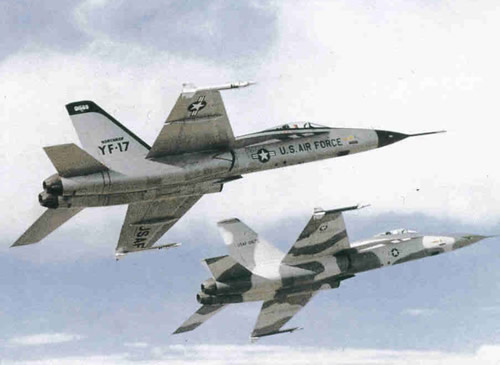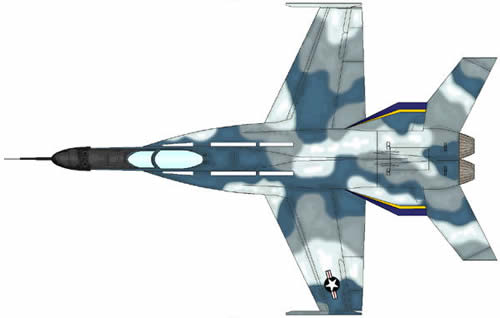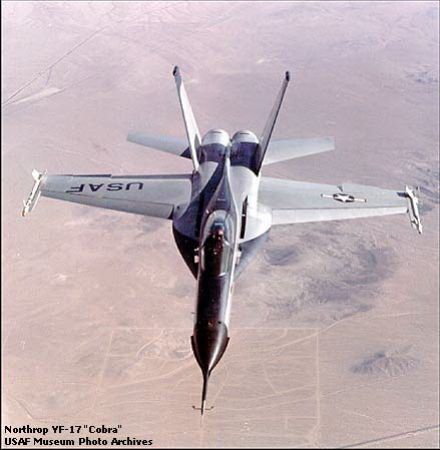|

Northrop’s YF-17 Lightweight Fighter
October 27th, 2007
By:
Raul Colon
e-mail:rcolonfrias@yahoo.com
PO Box 29754
Rio Piedras, Puerto Rico 00929

Throughout its military
aviation history, the United States had fielded some of the most advanced
fighters in the world. They also have been some of the heaviest planes
ever. When the United States entered the Korean War in the 1950s, they
were surprised by the advances of the Soviet Union’s fighter planes. The
new Mig fighters were lightweight and more manoeuvrable than their US
counterparts. Only the skills and training of the US Air Force pilots, not
their aircraft, provided America with air dominance over the Korean sky.
As the war progressed, the
US became more worried about a perceived Soviet advantage in fighter
design. As a result, the Lockheed Company began a crash coarse in the
design and development of the next generation US fighter, a fighter so
advanced that it could had ruled the skies for two decades. The result of
this massive effort was the F-104 Starfighter. Although the F-104 was
conceived to be America’s primary air superiority fighter, the Air Force
fiddles with the original design specifications and made the aircraft a
fighter-bomber. The F-104, beside its main objective of achieving air
dominance over the projected battlefield, was also designed to carry
nuclear ordinance. Thus the aircraft never achieved its pre-design
objective. The US next successful, true air superiority fighter would be
the F-4 Phantom. The F-4 proved itself over the skies in South-eastern
Asia.
Duelling with Mig fighters
it proved the worth of its design. By the mid 1960s, the US Air Force
again, worried about the nimbleness of Soviet fighter planes, and in the
midst of a generational change on its top brass structure; the old
bomber-supporter generals were being pushed out from mid to upper level
positions and replaced by fighter planes supporting majors and generals.
It was at this time that the Air Force, pushed by the new “fighter
establishment”, decided to commence a brand new fighter program. The
programme would stress the reduction in weight and the manoeuvrability of
aircraft above the multi-role profile that had dominated US recent fighter
development. This program would lead to the design and eventual
development of America’s first true lightweight fighter of the modern jet
age: the F-16 Fighting Falcon.

Since late 1966, the
Northrop Corporation had been developing an aircraft that would fit the
Air Force’s new specification requirements. Its first major design
breakthrough was the P-530, codename Cobra. Although the design never made
it past a mock-up project, the P-530 possessed many of the attributes,
both avionics packages and aerodynamics characteristics that were to
dominate post-Vietnam era fighter development in the United States. Armed
with this revolutionary design, Northrop entered the Air Force’s
competition for America’s next generation fighter development program in
the early 1970s. Based on massive amount of data collected during
Northrop’s designer Lee Begin’s research into lightweight fighter
platforms and the on the mock-up project P-530; Northrop began the design
of a new type of aircraft. The YF-17 project was born. The YF program was
Northrop’s entry into what was later refer to as the “The Deal of the
Century”. The “Deal” pitted the YF-17 platform against the FY-16 design.
Engineers at Northrop
designed the 17 into an all-weather fighter. Every advanced avionic
package, electronic system, and aerodynamic characteristic were
implemented into the new 17 fighter. What emerged was a truly remarkable
flying machine. The first test production FY-17, tail number 72-01569 was
fitted with two General Electric YJ101-GE-100 Turbojet engines with
afterburning capable of generating 14,415lb of thrust. The engines were
mounted close together in order to reduce the asymmetric effects on
handling in the event of an engine malfunction. The 17 fuselage was made
primarily of graphite composite alloys. The FY-17 was the first aircraft
design to incorporate leading edge root extensions. These extensions gave
the FY-17 excellent stability at a high angle of attack.
The wing structure
implemented a system of full span leading edges and half span trailing
edges flaps to provide the aircraft with good low speed performance. A set
of conventional ailerons and differential tailerons provided the 17 with
its roll control system. The wingtips were fitted with launch rails for
mounting air-to-air missiles. A twin tailfin configuration, canted
outwards in order to keep them out of the wake from the wing, was
incorporated. The aircraft’s rudders were relative small, reaching only to
halfway up the fins. A conventional cockpit was incorporated with the
purpose of providing the pilot with an excellent viewing area. The three
wheel landing mechanism was simple. It was composed of single-shock struts
and high pressure tires placed on each of the landing wheels.

Platform Specifications
Length 55’-0”
Height 14’-6”
Wing Area 350sq ft
Span 35’-0”
Maximum Weight Capacity 30,567lb
Operational Range 2,790 miles
Service Ceiling 59,800’
Maximum Speed 1,316mph at 40,000’
Weapon System Capability
One General Electric 20mm M61a1 Vulcan Cannon
Two AIM9 Sidewinder Missiles
Pylons for Two Mk 84 bombs
On the morning of June 9th, 1974; the FY-17 took to the air for its maiden
fly. A second prototype was built, tail number 72-01570 for testing
purposes only. Between the two units, they logged over 600 flights. The
aircraft was highly regarded by the sixty test pilots who flew it. There
were rumours that the 17 flew mock combat missions against capture Mig 17s
and 21s over the Nevada desert and that the aircraft performed beyond
expectations, but ultimately, the FY-17 lost the “Deal” competition and
the FY-16 went on to become NATO’s mainstay, front-line fighter. Although
stunned by the decision made by the Air Force, Northrop still planned to
produce the aircraft. But export orders for the FY-17 were slow to come
and the program was terminated soon after its showdown with the FY-16. But
the demise of 17 design concept was short-lived. In September 1974, the
McDonnell Douglas Corporation agreed to develop a naval version of the 17,
which was called the Hornet. The Hornet and its successor, the Super
Hornet have become the United States Navy’s main fleet defence fighter as
well as attack and reconnaissance aircraft.
|
